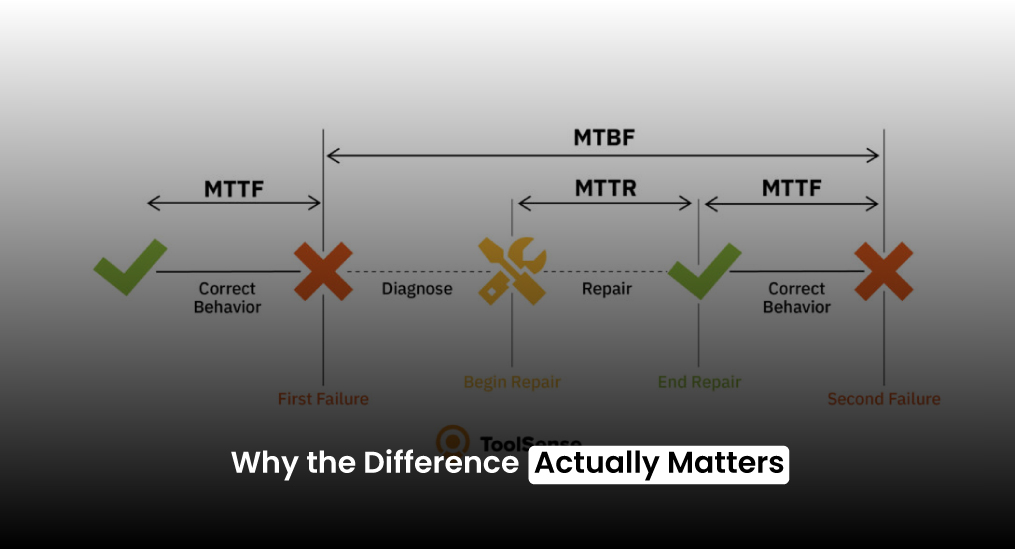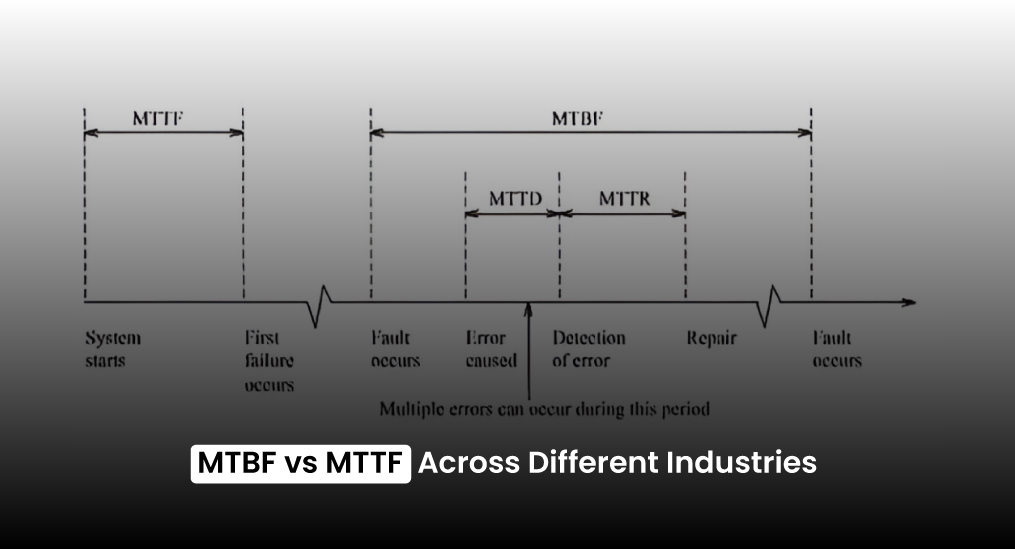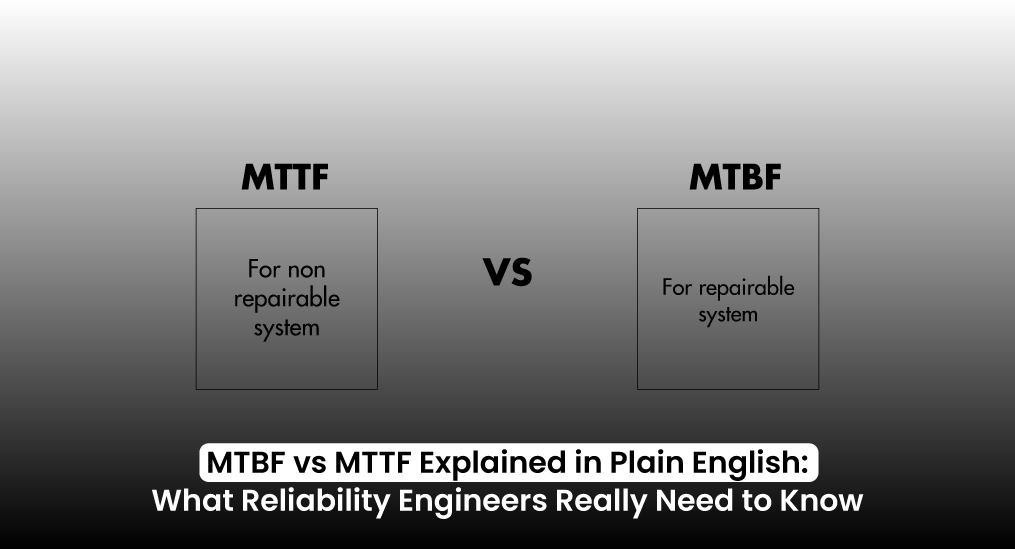You will come across phrases like MTBF vs MTTF if you have been dealing with equipment and machinery for an extended period of time. And it’s easy to assume they mean the same thing because they sound almost the same. However, they don’t, and combining them can cause serious issues.
How you schedule maintenance, monitor dependability, and handle downtime is impacted by the distinction between the two. You risk missing failure indicators, changing parts too soon, or disrupting your entire timetable if you depend on the incorrect one.
This blog explains the meaning of each phrase, how to use it, and why it’s essential for the daily tasks involved in maintaining your systems.
What Do MTBF and MTTF Even Stand For?
MTBF stands for Mean Time Between Failures, and MTTF stands for Mean Time To Failure. Despite their nearly identical sounds and frequent confusion, they have quite different meanings.
MTBF is for repairable equipment. It indicates how long an item usually lasts before breaking down and requiring maintenance. You can’t fix parts with MTTF. When they malfunction, you swap them out. MTBF would apply to a motor or pump, whereas MTTF would be used to measure a fuse or sensor. Making the appropriate plans and avoiding misunderstanding later on is made easier when you know which one to employ.
MTBF vs MTTF: Let’s Make It Real
To understand the difference between MTBF and MTTF, it helps to look at a real situation. Let’s say you’re working in a facility that uses an industrial air compressor and a simple temperature sensor. The air compressor is something you can repair when it breaks down. The temperature sensor isn’t. Once it fails, you just replace it.
Now, after a few months of tracking, you notice the air compressor usually runs about 500 hours before it breaks down. You fix it each time and keep it in service. That average of 500 hours between breakdowns is your MTBF. It tells you how long the equipment tends to last before it needs attention.
The temperature sensor works differently. Once it fails, it’s done. You’ve looked at data from a few hundred sensors and found they usually last about 120 hours. That number is your MTTF. It gives you a sense of how long a part will last before it needs to be replaced.
Using the right number helps you plan better. MTBF tells you when to expect repairs. MTTF tells you when to expect replacements. If you confuse the two, you might schedule maintenance too early, or worse, miss it entirely. Either mistake can lead to lost time and extra costs.
Why the Difference Actually Matters

This isn’t just a technical detail. It has real consequences.
Think about what happens if you plan preventive maintenance using MTTF for something that’s actually repairable. You could end up replacing parts too soon and wasting money, or worse, you might miss the right time to service the equipment and deal with an unexpected breakdown.
Now flip it. If you apply MTBF to something that gets thrown out when it fails, you’re just making the process more complicated than it needs to be. And you’re likely making choices based on the wrong assumptions.
Getting MTBF and MTTF mixed up can lead to:
- Buying the wrong kind or amount of spare parts
- Misreading how reliable your systems actually are
- Setting up maintenance schedules that don’t make sense
- Confusion between your engineers, operators, and procurement team
In industries where every hour matters—like manufacturing, oil and gas, utilities, or aerospace—these mix-ups can cause serious delays and extra costs. Understanding the difference helps you avoid all that.
How Are MTBF and MTTF Calculated?
Don’t worry, the math is simple. Here’s how it works.
MTBF (for repairable systems):
The formula is:
MTBF = Total Operating Time / Number of Failures
For example, say you have a pump that runs for 15,000 hours and breaks down 30 times during that period.
15,000 ÷ 30 = 500 hours
So, on average, that pump runs for 500 hours between failures.
MTTF (for non-repairable items):
The formula is:
MTTF = Total Time of All Units / Number of Units
Let’s say you test 200 light sensors, and together they run for 24,000 hours before failing.
24,000 ÷ 200 = 120 hours
That means each sensor lasts about 120 hours before it fails.
Keep in mind, these are averages. They don’t predict exactly when something will break, but the more data you collect, the more reliable these numbers become. Over time, they help you see how your equipment actually behaves in the real world.
That’s why a lot of teams use standard methods to calculate MTBF, especially in industries like telecom or aerospace, where reliability matters. One example is the Telcordia MTBF standard. It lays out a straightforward way to estimate how often things will fail based on real-world use. When everyone uses the same approach, it’s easier to compare systems and make decisions with confidence.
The Most Common Mistakes People Make

A lot of businesses get this wrong—big ones included. Here are some of the usual slip-ups:
- Using MTTF for something that gets repaired
This leads to a false sense of how reliable the equipment really is. You could end up replacing a part that’s still working just fine, simply because the data got misread. - Using MTBF for disposable items
It doesn’t make sense. If you’re not repairing the item, there is no “between failures.” You’re just making things more complicated than they need to be. - Trusting manufacturer specs without question
Numbers from a lab don’t always match what happens on your shop floor. A part that lasts 1,000 hours in clean conditions might not survive 300 hours in your dusty, high-vibration environment. - Assuming MTBF means uptime
It doesn’t. MTBF tells you how often something fails, not how long it stays up and running.
Getting clear on the difference between MTBF and MTTF helps you avoid these common traps. It keeps your maintenance plans realistic and based on what’s actually happening, not what the brochure says.
What These Metrics Actually Tell You
MTBF and MTTF aren’t just numbers on a report. They help you understand what’s really going on with your equipment. Here’s how:
- Spotting failure patterns
Over time, you can see if things are breaking down more often or if the timing stays consistent. That tells you whether your system is holding up or starting to wear out. - Planning maintenance
If you know a part usually fails around the 100-hour mark, you can plan to check or replace it before that happens. It’s a simple way to stay ahead of problems. - Managing spare parts and inventory
When a non-repairable part fails often, you’ll want to keep a few extras on hand. That way, you’re not scrambling when something stops working. - Avoiding surprise breakdowns
By tracking these numbers, you get better at predicting issues before they become emergencies. That means fewer interruptions when it matters most.
Beyond maintenance, these reliability figures also play a role in business decisions, especially when it comes to negotiating product guarantees or service contracts. Manufacturers often base coverage terms on expected failure rates, which is why understanding the link between MTBF and warranty strategy can give you leverage when evaluating vendors or managing risk on high-cost equipment.
MTBF vs MTTF Across Different Industries

These metrics aren’t just used in theory—they show up in real ways across different industries. Here’s how they play out:
Manufacturing
Machines like lathes, presses, and milling systems are built to repaired. MTBF helps teams plan for downtime, organize shifts, and schedule technicians. On the other hand, MTTF applies to parts like sensors or safety fuses that get replaced once they stop working.
Aviation
Every part of an aircraft is closely monitored. MTBF helps airlines track how often a component might fail so they can fix or replace it before it causes a problem. MTTF is used for smaller, throwaway parts like thermal fuses or plug-in electronic modules.
IT and Data Centers
MTBF helps estimate how often equipment like hard drives or servers might go down, which is key for scheduling backups and avoiding data loss. MTTF comes into play with cheaper parts like cooling fans or power supplies that get swapped out when they fail.
Medical Equipment
When lives are on the line, reliability is everything. MTBF helps predict when devices like ventilators or infusion pumps might need service. MTTF is tracked for disposable parts such as sensors, batteries, or cables that are changed out regularly.
In every case, knowing whether to use MTBF or MTTF helps people make better calls about maintenance, replacements, and planning.
Reliability isn’t just about keeping things running. It’s also about what it costs you over time. A piece of equipment that fails less often might cost more upfront, but it can save you money in the long run by cutting down on repairs, downtime, and labor. That’s why it helps to look at the MTBF lifecycle cost. When you think about how something performs over the years, not just the price on day one, you can make better choices about where your money goes.
What These Metrics Can’t Do
MTBF and MTTF are helpful, but they’re not magic solutions. There’s a lot they don’t tell you.
- They won’t tell you exactly when something will fail
These are averages. They give you a general idea, not a countdown clock. - They don’t explain why something failed
To figure that out, you still need to do a proper root cause analysis. - They don’t guarantee reliability
A part with an MTBF of 10,000 hours could still fail after 100. These numbers help you plan, but they don’t prevent problems on their own.
Think of MTBF vs MTTF as part of a bigger picture. They work best when used alongside condition monitoring, inspections, and past performance data. No single number can replace real-world observation and thoughtful planning.
MTBF vs MTTF isn’t just a technical detail. It’s a practical difference that can impact your daily operations. Whether you’re managing spare parts, building a maintenance plan, or reviewing supplier quotes, using the right metric helps you make better decisions.
Here’s a quick recap:
- MTBF – Use it for equipment you can repair
- MTTF – Use it for parts you replace when they fail
- Both help you plan better, avoid surprises, and save time
The key is to keep it simple. Use the right tool for the job, and always rely on your own real-world data. That’s what gives you the clearest picture of how your equipment is actually performing—not what the manual says, but what’s happening on your floor, day in and day out.






